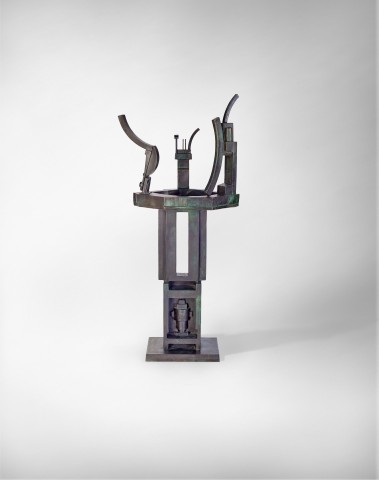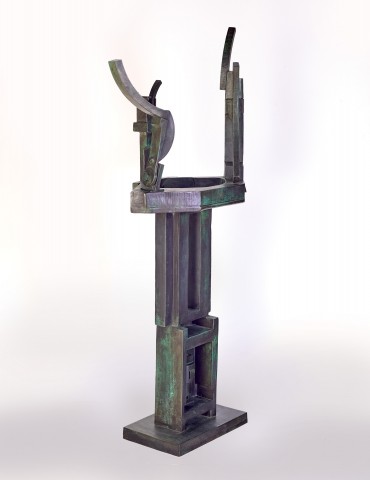NO. 448 BIRDBATH, 1982
ROBERT KLIPPEL
bronze
137.0 x 63.5 x 31.0 cm
signed with initials, dated and numbered on base: RK 448 82 AP
Meridian Melbourne foundry stamp at base
AP2 from an edition of 6 + 2AP
The Estate of the artist, Sydney
Annette Larkin Fine Art, Sydney
Private collection, Sydney, acquired from the above in 2013
Robert Klippel, Recent Sculpture and Works on Paper, Watters Gallery, Sydney, 16 November – 10 December 1983, cat. 73 (another example, illus. in exhibition catalogue)
Robert Klippel, Bronze Sculptures and Works on Paper, Pinacotheca, Melbourne, 14 November – 1 December 1984, cat. 18 (another example, illus. on front cover of exhibition catalogue)
Robert Klippel, Art Gallery of New South Wales, Sydney, 9 August – 13 October 2002 (another example)
Art in The Park XI 2013: Robert Klippel, Galerie Gmurzynska, Zurich, June – August 2013
Edwards, D., Robert Klippel, Art Gallery of New South Wales, Sydney, 2002, pp. 193 (illus.), 250
Edwards, D., Robert Klippel: A Catalogue Raisonné of Sculpture, CD–ROM, Art Gallery of New South Wales, Sydney, 2002, cat. 448 (illus., another example)
Robert Klippel – The American & European Years, Galerie Gmurzynska, Zurich, 2013, pp. 64 – 65 (illus.)
Another example from this edition is held in the Parliament House Art Collection, Canberra
With an unwavering artistic vision and continued inventiveness of form Robert Klippel became one of Australia’s most preeminent and original sculptors. In the early 1980s, the fourth decade of his artistic career, Klippel experienced a burst of creative activity stimulated by his rediscovery of wood – a material that not employed since his early carvings some forty years prior. No. 448 Birdbath, 1982 is a singular work in Klippel’s late oeuvre. Although its form is typically uncompromisingly abstract and geometric, the rare addition of a descriptive epithet for its first public exhibition1, Birdbath, adds a humorous and functional dimension to this monumental bronze cast. This title also recalls Klippel’s early flair for surrealist automatism and his continued use of the scavenged, found object. No 448, a table-like form, is constructed of a shallow hexagonal basin perched on a column of two stacked vertical blocks, topped with several jaunty curved elements, evenly balancing on the rim and extending joyfully into three dimensions.
In 1980, the burgeoning Australian National Gallery advertised their intention to commission contemporary Australian sculpture for their outdoor garden, piquing Klippel’s interest and sparking a new direction in his work towards monumental constructions in wood and bronze.2 No. 448 and over a hundred other constructions from this decade were borne from a vast pre-existing cache of wooden objects that the artist had stored in his Birchgrove home studio, a trove which Klippel called a ‘field’.3 These geometric fragments were obsolete pattern-parts of machinery, originally used to create moulds for metal castings, and had been found by chance by Klippel’s friend, the artist Colin Lancely between October 1963 and June 1964, in a disused store belonging to Morts, a shipbuilding firm operating a dry-dock in Balmain from the mid-19th century. For Klippel, a former WWII navy officer and engineer, the maritime applications of these blocky sections held special significance. Unlike Lanceley, whose baroque assemblages commenced immediately, Klippel waited some 20 years before incorporating the wooden parts into his sculptures, either retaining their original bright painted surfaces, or, as in No.448, sanded smooth and cast in monochrome bronze with ‘stately solemnity.’4
In incorporating into his constructions fragments of real machinery, Klippel’s doggedly abstract sculptures are animated with a poetic synthesis of industrial-mechanical and organic energies. Although using a base formal lexicon of arbours and cogs, pinions and axles, Klippel’s curved forms on the top of this construction echo the dynamic shapes of birds in flight, noisily enjoying a bath. A poetically simple composition, No. 448 is stripped down to a formal arrangement of a static and rectilinear base juxtaposed with an exuberant and asymmetric capital requiring a viewing in the round. Freestanding and bearing no fixed point of view, the viewer’s eye is instead drawn in multiple directions and perspectives. These additions to the top of the composition display a free and spontaneous handling of forms, placed casually as if by chance and defying physics by having been cast solidly together in perpetuity.
1. In the catalogue for Robert Klippel, Recent Sculpture and Works on Paper, Watters Gallery, Sydney, 15 November - 10 December 1983, No. 448 is both illustrated on the cover of the catalogue and features in the large list of 75 bronze sculptures as the only work with a descriptive title in addition to the consecutive RK number. The same is true for the Pinacotheca exhibition the following year.
2. Edwards, D., Robert Klippel, Art Gallery of New South Wales, Sydney, 2002, p. 188
3. Ibid.
4. Gleeson, J., Robert Klippel, Bay Books, Sydney, 1983, p. 413
LUCIE REEVES-SMITH


